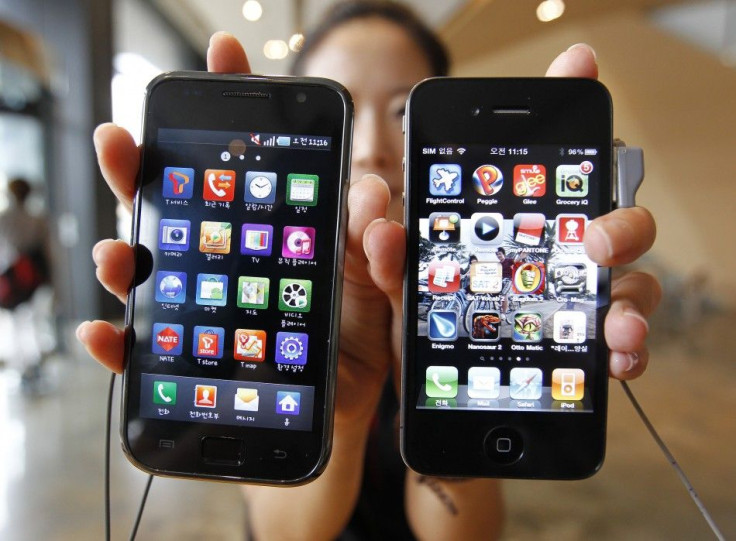Is Samsung's Galaxy S Really One Big iPhone Copycat?

When Samsung released its Galaxy S smartphone last year, many reviewers were almost immediately aware of how similar the device was to Apple's massively successful iPhone.
Everything from the phone's exterior to its user interface seem lifted directly from the design book of Steve Jobs himself. In the case of Samsung, imitation was indeed the most sincere form of flattery.
But as flattered as Apple may have been by Samsung's keen desire to copy its design aesthetic, the company wasn't happy with it. On April 15 Apple filed a lawsuit against Samsung, accusing the South Korean company of wholesale copying features of the iPhone for use in many of its own products. Much of the complaint focuses on the Samsung's Galaxy S, which Apple showcased in its court filing as the most egregious example of Samsung's imitation.
Rather than innovate and develop its own technology and a unique Samsung style for its smart phone products and computer tablets, Samsung chose to copy Apple's technology, user interface and innovative style in these infringing products, Apple said in the lawsuit.
But how similar are the devices, exactly?
The Trade Dress
In Apple's suit, the company goes to great lengths to prove that the Galaxy S is similar enough to the iPhone that the former can easily confused with the latter. Using the legal term trade dress Apple says that the iPhone has its own distinct style that signifies its unique identity. Samsung, Apple alleges, infringes on that identity when it copies the iPhone's style.
Trade dress is somewhat different from copyright or patents. It is related to trademarks. The designs of some products become so iconic or linked with a brand that other companies can't use them. Trade dress has to be a design element that doesn't affect the function of whatever the product is -- Apple can't sue Samsung for making a touch screen phone by itself. But they can sue over design elements that serve to make the iPhone distinctive in the consumer's mind. It's this point that will be contested.
The front faces of both phones are nearly identical, Apple says, noting that both devices feature four uniformly rounded corners, black borders, and a metallic frame wrapping around their perimeters. The similarities become more significant when the devices are powered on and their rows of colorful icons become visible.
Apple also has a reasonable case in comparing the often overwhelming similarities between the icons used in the iPhone and the Galaxy S. Consider the similarities between the phone icons of the devices, both of which feature white phones on top of a green background. The similarities carry over between the two devices so consistently that it almost seems systematic. This is one area where Samsung could have a tougher time defending itself against Apple's accusations.
The User Interface
In Apple's suit, the company provides a list of seven so-called utility patents that correspond to certain aspects of the iOS's user experience. Patent 7,812,828, for example, describes the iPhone's multi-touch capabilities, whereas 7,469,381 describes the pinch and rotate gestures used to manipulate documents on the iPhone's screen. These are technologies that Apple is accusing Samsung of using without permission. Samsung has not obtained permission from Apple to use its inventions in the identified utility patents, Apple says in the suit. According to Apple, Samsung has benefited from the unique functionality of the technologies without putting in the work to develop them. The first patent is also in a suit Apple has pending against Motorola.
Touchwiz, the Galaxy S's operating system, is a modified version of Android, making Samsung's tweaks all the more international and egregious. Both devices feature a dock that remains constant along the bottom of the screen as you scroll from one screen to another. The Galaxy S also borrows from iOS's notification system, adding a small red dot with a number when app seeks to notify users of new events.
From these similarities, it becomes increasingly clear that Samsung drew much of its Touchwiz inspiration from Apple's iOS -- but whether the courts think those similarities are close enough to constitute patent infringements still remains to be seen.
Apple is also litigating a hardware patent, for the rocker switch on the side of the iPhone 3GS and 3G (patent number 7,863,533). Samsung has a similar switch and that claim may be more straightforward. Later filings will likely involve the parties taking it apart to see just how similar they are.
Since most of Apple's litigation covers parts of the phone that don't affect function, it's interesting to look at how similar -- or not -- the technical specifications of the phones are, since one area of the suit is whether consumers think they are buying an iPhone based on the look and feel.
Take the screen. At 4 inches, the Galaxy S's super-AMOLED screen is a half-inch larger than the iPhone 4's retina display. But the iPhone 969X640 display gives the phone the edge over the 800X480 display on the Galaxy S, which pales in comparison. In this respect, the two phones are on entirely different levels, especially considering that the Retina display is one of the iPhone's primary selling points.
Samsung is also available on a wider range of service providers than the iPhone is (T-Mobile and U.S. Cellular, for instance, offer the Galaxy S). That is something many consumers do notice -- and may serve as a differentiator from the iPhone.
Samsung itself has filed its own set of lawsuits overseas, accusing Apple of infringing several technologies in areas similar to those Apple is claiming. Unlike Apple's suit those are more hardware-based patents, and Apple will have to fight those in Korea, Japan and Germany.
© Copyright IBTimes 2024. All rights reserved.




















